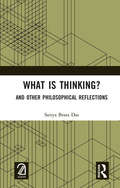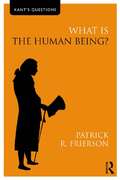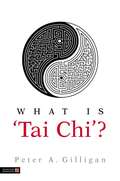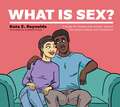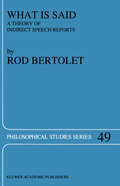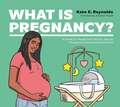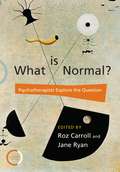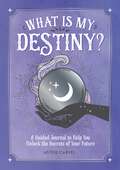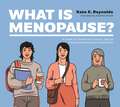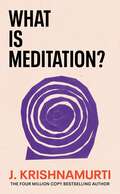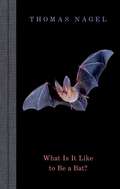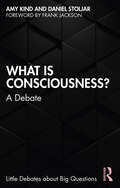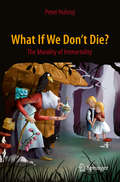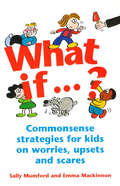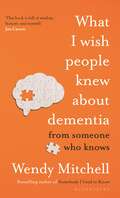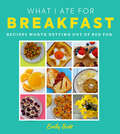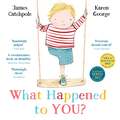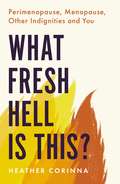- Table View
- List View
What is Thinking?: And Other Philosophical Reflections
by Saitya Brata DasThe philosophical essays of this collection argue, each time from a singular perspective, that the task of thinking is to release the element of the unconditional from various closures, and thus to make it manifest as the true and the essential task of our individual and social existence. Naming this unconditional element as the "messianic", the book displays the profound ethico-political significance of messianic thought for our contemporary world. Please note: Taylor & Francis does not sell or distribute the Hardback in India, Pakistan, Nepal, Bhutan, Bangladesh and Sri Lanka.
What is the Human Being?
by Patrick R. FriersonPhilosophers, anthropologists and biologists have long puzzled over the question of human nature. It is also a question that Kant thought about deeply and returned to in many of his writings. In this lucid and wide-ranging introduction to Kant’s philosophy of human nature - which is essential for understanding his thought as a whole - Patrick R. Frierson assesses Kant’s theories and examines his critics. He begins by explaining how Kant articulates three ways of addressing the question ‘what is the human being?’: the transcendental, the empirical, and the pragmatic. He then considers some of the great theorists of human nature who wrestle with Kant’s views, such as Hegel, Marx, Darwin, Nietzsche, and Freud; contemporary thinkers such as E.O.Wilson and Daniel Dennett, who have sought biological explanations of human nature; Thomas Kuhn, Michel Foucault, and Clifford Geertz, who emphasize the diversity of human beings in different times and places; and existentialist philosophers such as Sartre and Heidegger. He argues that whilst these approaches challenge and enrich Kant’s views in significant ways, all suffer from serious weaknesses that Kant’s anthropology can address. Taking a core insight of Kant’s - that human beings are fundamentally free but finite - he argues that it is the existentialists, particularly Sartre, who are the most direct heirs of his transcendental anthropology. The final part of the book is an extremely helpful overview of the work of contemporary philosophers, particularly Christine Korsgaard and Jürgen Habermas. Patrick R. Frierson explains how these philosophers engage with questions of naturalism, historicism, and existentialism while developing Kantian conceptions of the human being. Including chapter summaries and annotated further reading, What is the Human Being? is an outstanding introduction to some fundamental aspects of Kant’s thought and a judicious assessment of leading theories of human nature. It is essential reading for all students of Kant and the philosophy of human nature, as well as those in related disciplines such as anthropology, politics and sociology.
What is the Human Being? (Kant's Questions)
by Patrick R. FriersonPhilosophers, anthropologists and biologists have long puzzled over the question of human nature. It is also a question that Kant thought about deeply and returned to in many of his writings. In this lucid and wide-ranging introduction to Kant’s philosophy of human nature - which is essential for understanding his thought as a whole - Patrick R. Frierson assesses Kant’s theories and examines his critics. He begins by explaining how Kant articulates three ways of addressing the question ‘what is the human being?’: the transcendental, the empirical, and the pragmatic. He then considers some of the great theorists of human nature who wrestle with Kant’s views, such as Hegel, Marx, Darwin, Nietzsche, and Freud; contemporary thinkers such as E.O.Wilson and Daniel Dennett, who have sought biological explanations of human nature; Thomas Kuhn, Michel Foucault, and Clifford Geertz, who emphasize the diversity of human beings in different times and places; and existentialist philosophers such as Sartre and Heidegger. He argues that whilst these approaches challenge and enrich Kant’s views in significant ways, all suffer from serious weaknesses that Kant’s anthropology can address. Taking a core insight of Kant’s - that human beings are fundamentally free but finite - he argues that it is the existentialists, particularly Sartre, who are the most direct heirs of his transcendental anthropology. The final part of the book is an extremely helpful overview of the work of contemporary philosophers, particularly Christine Korsgaard and Jürgen Habermas. Patrick R. Frierson explains how these philosophers engage with questions of naturalism, historicism, and existentialism while developing Kantian conceptions of the human being. Including chapter summaries and annotated further reading, What is the Human Being? is an outstanding introduction to some fundamental aspects of Kant’s thought and a judicious assessment of leading theories of human nature. It is essential reading for all students of Kant and the philosophy of human nature, as well as those in related disciplines such as anthropology, politics and sociology.
What is 'Tai Chi'? (PDF)
by Peter GilliganThis book grew out of a question one of the author's students asked. The answer proved to be longer than either teacher or student could have anticipated. Â As he looks at the complex art of 'Tai Chi', the author answers questions such as why, unlike in other martial arts, 'Tai Chi' has no gradings; how hard you should try; and how to make the most of your teacher. A wide range of material is covered, including fundamental points about the mechanics of movement and the 'energetic' aspects of practice, as well as the relationship between body, mind and spirit that emerges. The author also provides answers to questions that even experienced practitioners may not have thought to ask, such as what are the levels of self-defense in 'Tai Chi'? How do I refine and develop my 'Tai Chi'? What is the difference between method and technique? How do I put principles into practice? Â This insightful book covers all aspects of 'Tai Chi', answering questions that are beyond the scope of many classes. It will be of interest to anyone beginning 'Tai Chi' or Qi Gong, as well as to more experienced practitioners at all levels, practitioners of other martial arts, and friends and relatives of "Tai Chi" players who wonder what all the fuss and enthusiasm is about.
What is 'Tai Chi'?
by Peter GilliganThis book grew out of a question one of the author's students asked. The answer proved to be longer than either teacher or student could have anticipated. Â As he looks at the complex art of 'Tai Chi', the author answers questions such as why, unlike in other martial arts, 'Tai Chi' has no gradings; how hard you should try; and how to make the most of your teacher. A wide range of material is covered, including fundamental points about the mechanics of movement and the 'energetic' aspects of practice, as well as the relationship between body, mind and spirit that emerges. The author also provides answers to questions that even experienced practitioners may not have thought to ask, such as what are the levels of self-defense in 'Tai Chi'? How do I refine and develop my 'Tai Chi'? What is the difference between method and technique? How do I put principles into practice? Â This insightful book covers all aspects of 'Tai Chi', answering questions that are beyond the scope of many classes. It will be of interest to anyone beginning 'Tai Chi' or Qi Gong, as well as to more experienced practitioners at all levels, practitioners of other martial arts, and friends and relatives of "Tai Chi" players who wonder what all the fuss and enthusiasm is about.
What is Social Work?: Context and Perspectives (3rd edition) (PDF)
by Nigel HornerNow in its third edition, this classic social work text explores the foundations of social care in the UK, how it evolved and why. It answers key questions on mental health, working with older people, working with families and children and much more. With expanded chapters on international social work, the new directions for social care and the implications of interprofessional working, this text is widely considered the best introduction to the subject a social work student can have.
What Is Sex?: A Guide for People with Autism, Special Educational Needs and Disabilities (Healthy Loving, Healthy Living)
by Kate E. ReynoldsThis carefully written and illustrated book provides an explanation of sex for people with autism and special education needs and disabilities (SEND). It helps readers to understand the physical processes as well as important issues such as consent and sexual safety, helping them to develop positive relationships.Many people with autism and SEND have or will have intimate relationships. Often sex is alluded to, rather than being carefully explored. This can create confusion around consent, sexual health, and pregnancy, and cause people to turn to dubious online information. This book frankly explains sex so that the reader has a clear understanding of what constitutes sex, knowledge of the proper names for sexual organs and sexual activities, and is aware of the potential physical consequences of having sex.
What Is Sex?: A Guide for People with Autism, Special Educational Needs and Disabilities (Healthy Loving, Healthy Living)
by Kate E. ReynoldsThis carefully written and illustrated book provides an explanation of sex for people with autism and special education needs and disabilities (SEND). It helps readers to understand the physical processes as well as important issues such as consent and sexual safety, helping them to develop positive relationships.Many people with autism and SEND have or will have intimate relationships. Often sex is alluded to, rather than being carefully explored. This can create confusion around consent, sexual health, and pregnancy, and cause people to turn to dubious online information. This book frankly explains sex so that the reader has a clear understanding of what constitutes sex, knowledge of the proper names for sexual organs and sexual activities, and is aware of the potential physical consequences of having sex.
What is Said: A Theory of Indirect Speech Reports (Philosophical Studies Series #49)
by R. BertoletThe notion of what someone says is, perhaps surprisingly, some what less clear than we might be entitled to expect. Suppose that I utter to my class the sentence 'I want you to write a paper reconciling the things Russell claims about propositions in The Philosophy of Mathematics for next week'. A student who was unable to get up in time for class that day asks another what I said about the assignment. Several replies are in the offing. One, an oratio recta or direct speech report, is 'He said, "I want you to write a paper reconciling the things Russell claims about propositions in The Philosophy of Mathematics for next week. '" Another, an oratio obliqua or indirect speech report, consists in the response 'He said that he wants us to write a paper reconciling . . . '. Yet another, reflecting a perhaps accurate estimate of the task involved, editorializes: 'He said he wants us to do the impossible'. Or, aware of both this and my quaint custom of barring those who have not successfully completed the assignment from the classroom, one might retort 'He said he doesn't want to meet next week'. Since 'says' is construable in these various ways, it is at best unhelpful to write something like 'Alice said "Your paper is two days late", thereby saying that Tom's paper was two days late.
What Is Pregnancy?: A Guide for People with Autism, Special Educational Needs and Disabilities (Healthy Loving, Healthy Living)
by Kate E. ReynoldsThis carefully written and illustrated book provides an explanation of pregnancy for people with autism and special education needs and disabilities (SEND). It helps readers to understand the physical processes of pregnancy, as well as important practical information, such as how to stay healthy in pregnancy, antenatal care, the role of the midwife and the involvement of partners.Many people with autism and SEND may want or plan to have children. Many women who have autism, special educational needs and disabilities (SEND) have poor experiences of prenatal and postnatal care and high levels of stress, anxiety and depression or do not disclose their pregnancy until far into their terms due to fears of forced termination. This book frankly explains pregnancy so that the reader has a clear understanding of what constitutes pregnancy, what happens during labour and is aware of their legal right to create a family.
What is Normal?: Psychotherapists Explore the Question
by Jane Ryan Roz CarrollThis volume explores contemporary notions of normality and how the therapy profession is engaging with that question today. Can ‘being normal’ ever be observed and tested? Who defines the norm of the mental health? Is it constrained by a social concept of normal? And how do we ever reach an understanding of ‘not normal’.
What is My Destiny?: A Guided Journal to Help You Unlock the Secrets of Your Future
by Astrid CarvelThis guided journal contains everything you need to learn the skills of the clairvoyant and decipher messages from the universeThe ability to foresee our future is something we all long for, and with the help of this guided journal you’ll find yourself harnessing your psychic abilities in no time. From naeviology to numerology, tasseography to tarot and everything in between, this book will be your ultimate guide to fortune telling.Discover the fascinating history behind different divination techniques and how to tap into your own magical abilities with step-by-step instructions and thought-provoking questions. Packed with activities, methods and space to log your interpretations and findings, this book will help you develop your psychic gifts and discover your true path.Learn how to:Analyze the lines and formations of your palmCreate your own dowsing rods and master the art of rhabdomancyInterpret the meaning behind your dreamsDecipher your birth chartYour destiny awaits!
What Is Menopause?: A Guide for People with Autism, Special Educational Needs and Disabilities
by Kate E. ReynoldsThis carefully written and explicitly illustrated book provides an explanation of menopause for people with autism and special education needs and disabilities (SEND). It helps readers to understand the physical processes and symptoms of menopause, as well as important practical information, such as how to cope with the emotional and hormonal changes in menopause, complementary therapies and tips on how to effectively communicate your experiences to support networks and professionals such as, doctors and therapists.Menopause is rarely recognised or addressed with people who have autism, special educational needs and disabilities (SEND) yet it has a significant impact on their daily living. This book frankly explains what constitutes menopause, that it is part of the life course and can be actively managed. As part of the 'Healthy Loving, Healthy Living' series, this book is written in gender neutral and inclusive language.
What Is Menopause?: A Guide for People with Autism, Special Educational Needs and Disabilities
by Kate E. ReynoldsThis carefully written and explicitly illustrated book provides an explanation of menopause for people with autism and special education needs and disabilities (SEND). It helps readers to understand the physical processes and symptoms of menopause, as well as important practical information, such as how to cope with the emotional and hormonal changes in menopause, complementary therapies and tips on how to effectively communicate your experiences to support networks and professionals such as, doctors and therapists.Menopause is rarely recognised or addressed with people who have autism, special educational needs and disabilities (SEND) yet it has a significant impact on their daily living. This book frankly explains what constitutes menopause, that it is part of the life course and can be actively managed. As part of the 'Healthy Loving, Healthy Living' series, this book is written in gender neutral and inclusive language.
What is Meditation?
by J. KrishnamurtiMeditation is freeing the mind from the knownIn this inspiring collection of quotations, world renowned spiritual thinker J. Krishnamurti offers an insightful guide to the art of meditation and why it is important in helping us all face the challenges of modern life.
What Is It Like to Be a Bat?
by Thomas NagelA 50th anniversary edition of one of the most widely influential articles of 20th Century philosophy ?Consciousness is what makes the mind-body problem really intractable.? So begins Thomas Nagel's classic 1974 essay ?What is it Like to be a Bat?? Nagel's essay initiated the now widespread attention to consciousness as a central problem for philosophy, psychology, and neuroscience; it also influenced the recognition of the consciousness of nonhuman creatures as an important subject of study. Nagel argued that the essential subjectivity of conscious experience--what it is like for the creature undergoing it--means that reductionist theories of mind, which attempt to analyze it in physical terms, can never succeed. It follows that the physical sciences cannot provide a complete description of reality, and that the physical conception of objective reality must be transcended if science is going to comprehend the mind. This edition reissues this classic and widely influential article on its 50th anniversary, along with a new preface discussing the origins and influence of the essay, as well as ?Further Thoughts: The Psychophysical Nexus,? a supplementary essay which describes Nagel's later thoughts about how to respond to the problem posed by ?What Is It Like to Be a Bat?? This second essay suggests that the most promising path forward for the mind-body problem, if one accepts the irreducible subjectivity of consciousness, is to seek a necessary connection between mental and neurophysiogical states through a more fundamental type of state which is neither mental nor physical but necessitates them both as essential aspects. In other words, a state that is physical from the outside and mental from the inside, just as we are. This would be a form of monism, requiring the formation of new concepts, since our present concepts of the mental and the physical do not entail such a necessary connection. The essay explains why the relation between the mental and the physical may be necessary, even though our present concepts make it appear contingent.
What Is It Like to Be a Bat?
by Thomas NagelA 50th anniversary edition of one of the most widely influential articles of 20th Century philosophy ?Consciousness is what makes the mind-body problem really intractable.? So begins Thomas Nagel's classic 1974 essay ?What is it Like to be a Bat?? Nagel's essay initiated the now widespread attention to consciousness as a central problem for philosophy, psychology, and neuroscience; it also influenced the recognition of the consciousness of nonhuman creatures as an important subject of study. Nagel argued that the essential subjectivity of conscious experience--what it is like for the creature undergoing it--means that reductionist theories of mind, which attempt to analyze it in physical terms, can never succeed. It follows that the physical sciences cannot provide a complete description of reality, and that the physical conception of objective reality must be transcended if science is going to comprehend the mind. This edition reissues this classic and widely influential article on its 50th anniversary, along with a new preface discussing the origins and influence of the essay, as well as ?Further Thoughts: The Psychophysical Nexus,? a supplementary essay which describes Nagel's later thoughts about how to respond to the problem posed by ?What Is It Like to Be a Bat?? This second essay suggests that the most promising path forward for the mind-body problem, if one accepts the irreducible subjectivity of consciousness, is to seek a necessary connection between mental and neurophysiogical states through a more fundamental type of state which is neither mental nor physical but necessitates them both as essential aspects. In other words, a state that is physical from the outside and mental from the inside, just as we are. This would be a form of monism, requiring the formation of new concepts, since our present concepts of the mental and the physical do not entail such a necessary connection. The essay explains why the relation between the mental and the physical may be necessary, even though our present concepts make it appear contingent.
What is Consciousness?: A Debate (Little Debates about Big Questions)
by Amy Kind Daniel StoljarWhat is consciousness and why is it so philosophically and scientifically puzzling? For many years philosophers approached this question assuming a standard physicalist framework on which consciousness can be explained by contemporary physics, biology, neuroscience, and cognitive science. This book is a debate between two philosophers who are united in their rejection of this kind of "standard" physicalism—but who differ sharply in what lesson to draw from this. Amy Kind defends dualism 2.0, a thoroughly modern version of dualism (the theory that there are two fundamentally different kinds of things in the world: those that are physical and those that are mental) decoupled from any religious or non-scientific connotations. Daniel Stoljar defends non-standard physicalism, a kind of physicalism different from both the standard version and dualism 2.0. The book presents a cutting-edge assessment of the philosophy of consciousness and provides a glimpse at what the future study of this area might bring. Key Features Outlines the different things people mean by "consciousness" and provides an account of what consciousness is. Reviews the key arguments for thinking that consciousness is incompatible with physicalism. Explores and provides a defense of contrasting responses to those arguments, with a special focus on responses that reject the standard physicalist framework. Provides an account of the basic aims of the science of consciousness. Written in a lively and accessibly style. Includes a comprehensive glossary.
What is Consciousness?: A Debate (Little Debates about Big Questions)
by Amy Kind Daniel StoljarWhat is consciousness and why is it so philosophically and scientifically puzzling? For many years philosophers approached this question assuming a standard physicalist framework on which consciousness can be explained by contemporary physics, biology, neuroscience, and cognitive science. This book is a debate between two philosophers who are united in their rejection of this kind of "standard" physicalism—but who differ sharply in what lesson to draw from this. Amy Kind defends dualism 2.0, a thoroughly modern version of dualism (the theory that there are two fundamentally different kinds of things in the world: those that are physical and those that are mental) decoupled from any religious or non-scientific connotations. Daniel Stoljar defends non-standard physicalism, a kind of physicalism different from both the standard version and dualism 2.0. The book presents a cutting-edge assessment of the philosophy of consciousness and provides a glimpse at what the future study of this area might bring. Key Features Outlines the different things people mean by "consciousness" and provides an account of what consciousness is. Reviews the key arguments for thinking that consciousness is incompatible with physicalism. Explores and provides a defense of contrasting responses to those arguments, with a special focus on responses that reject the standard physicalist framework. Provides an account of the basic aims of the science of consciousness. Written in a lively and accessibly style. Includes a comprehensive glossary.
What If We Don't Die?: The Morality of Immortality (Springer Praxis Books)
by Peter HulsrojThis book deals with the very real possibility of earthly immortality and the human and societal implications of such immortality, including whether it is desirable.It looks at what makes immortality appear so attractive and at the possibility that we would be better served with longer lives and the freedom to terminate our lives at the time when life has given us all the joy, inspiration and personal development it possibly could.What If We Don’t Die?- Presents major moral dilemmas associated with human immortality, something which seems imminent due to rapidly progressing biomedical research.- Touches on big questions: is it acceptable that the immortal generation will be the last? How much life do you want? What is the purpose of life if life never ends?- Will trigger your imagination by putting a new spin on free will, current concepts of time and eternity, the possibility of multiple universes and multiple yous. What If We Don’t Die? draws extensively on philosophical and religious thought on the purpose of life and introduces novel perspectives on existence, personality and immortality based, for instance, on quantum mechanics and multiverse theory.
What If...?: Commonsense strategies for kids on worries, upsets and scares
by Mumford , Sally & Mackinnon , Emma Sally MumfordWhat if ......Your front tooth is knocked out?...You are staying at a friend's house and by mistake you break something?...You come home from school and you smell gas?...Your hamster has escaped?...You are bullied at school?...There is a strange man lurking by the playground?Today's world is perceived to be a much more dangerous place than it was twenty or thirty years' ago. Whether it is or not, events can happen in everyday life which can worry, scare or upset a child. What if... aims to provide children with basic, practical, commonsense strategies to deal with life - at school, at home, at a friend's house and out & about.Containing up to 100 different scenarios, What if... is designed to appeal to children as they learn to deal with life independently and is an essential reference for all parents and teachers who want to bring up confident, happy children.
What I Wish People Knew About Dementia: The Sunday Times Bestseller
by Wendy MitchellTHE SUNDAY TIMES BESTSELLER'Essential reading' SUNDAY TIMES MAGAZINE'A book of hope' OBSERVER'A marvellous tour of insights' THE TIMES'A must-read . . . I couldn't recommend it higher' MICHAEL BALL'Wendy Mitchell is a life-saver' FRANCES WILSON, AUTHOR OF BURNING MANWhat can a diseased brain tell us about being human, living our own lives better and helping those with dementia get the best from theirs?When Wendy Mitchell was diagnosed with young-onset dementia at the age of fifty-eight, her brain was overwhelmed with images of the last stages of the disease - those familiar tropes, shortcuts and clichés that we are fed by the media, or even our own health professionals. But her diagnosis far from represented the end of her life. Instead, it was the start of a very different one. Wise, practical and life affirming, What I Wish People Knew About Dementia combines anecdotes, research and Wendy Mitchell's own brilliant wit and wisdom to tell readers exactly what she wishes they knew about dementia.
What I Ate for Breakfast: Food Worth Getting Out Of Bed For
by Emily ScottMove over soggy cereal and plain toast, there’s a new skillet in town…
What Happened to You?
by James CatchpoleThe first ever picture book addressing how a disabled child might want to be spoken to.What happened to you? Was it a shark? A burglar? A lion? Did it fall off?Every time Joe goes out the questions are the same . . . what happened to his leg? But is this even a question Joe has to answer?A ground-breaking, funny story that helps children understand what it might feel like to be seen as different.
What Fresh Hell Is This?: Perimenopause, Menopause, Other Indignities and You
by Heather Corinna'This book feels like your best friend talking to you over drinks - if your best friend is a shit-talking, patriarchy-smashing, intersectionally feminist professor of the history of reproductive medicine and also an endocrinologist with a side hustle as a comedian.' - Dr Emily Nagoski, NYT bestselling author of Come As You AreWhat to Expect When You're Not Expected to Expect Anything AnymorePerimenopause and menopause experiences are as unique as all of us who move through them. While there's no one-size-fits-all, Heather Corinna tells you what can happen and what you can do to take care of yourself, all the while busting pernicious myths, offering real self-care tips - the kind that won't break the bank or your soul - and running the gamut from hot flashes to hormone therapy.With practical, clear information and support, inclusive of those with disabilities, queer, transgender, nonbinary and other gender-diverse people, people of colour, working class and others who have long been left out of the discussion, What Fresh Hell Is This? is the cooling pillow and empathetic best friend to help you through the fire.
